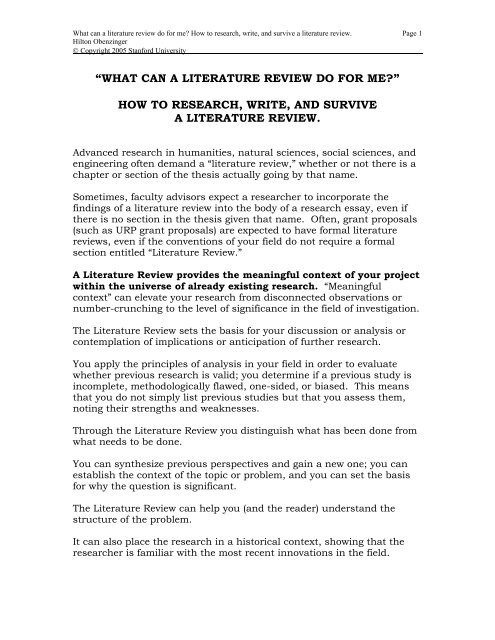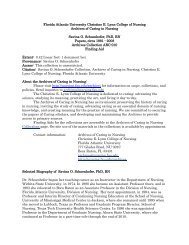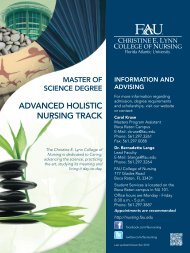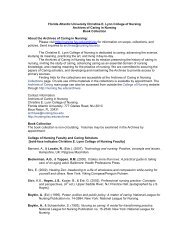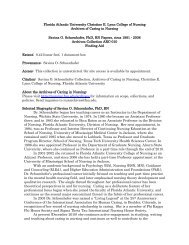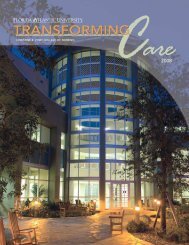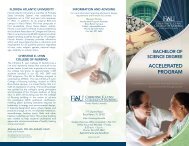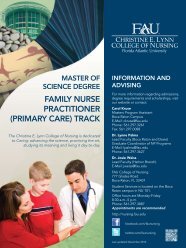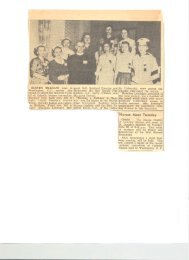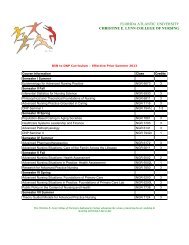âWHAT CAN A LITERATURE REVIEW DO FOR ME?â HOW TO ...
âWHAT CAN A LITERATURE REVIEW DO FOR ME?â HOW TO ...
âWHAT CAN A LITERATURE REVIEW DO FOR ME?â HOW TO ...
You also want an ePaper? Increase the reach of your titles
YUMPU automatically turns print PDFs into web optimized ePapers that Google loves.
What can a literature review do for me? How to research, write, and survive a literature review. Page 1Hilton Obenzinger© Copyright 2005 Stanford University“WHAT <strong>CAN</strong> A <strong>LITERATURE</strong> <strong>REVIEW</strong> <strong>DO</strong> <strong>FOR</strong> <strong>ME</strong>?”<strong>HOW</strong> <strong>TO</strong> RESEARCH, WRITE, AND SURVIVEA <strong>LITERATURE</strong> <strong>REVIEW</strong>.Advanced research in humanities, natural sciences, social sciences, andengineering often demand a “literature review,” whether or not there is achapter or section of the thesis actually going by that name.Sometimes, faculty advisors expect a researcher to incorporate thefindings of a literature review into the body of a research essay, even ifthere is no section in the thesis given that name. Often, grant proposals(such as URP grant proposals) are expected to have formal literaturereviews, even if the conventions of your field do not require a formalsection entitled “Literature Review.”A Literature Review provides the meaningful context of your projectwithin the universe of already existing research. “Meaningfulcontext” can elevate your research from disconnected observations ornumber-crunching to the level of significance in the field of investigation.The Literature Review sets the basis for your discussion or analysis orcontemplation of implications or anticipation of further research.You apply the principles of analysis in your field in order to evaluatewhether previous research is valid; you determine if a previous study isincomplete, methodologically flawed, one-sided, or biased. This meansthat you do not simply list previous studies but that you assess them,noting their strengths and weaknesses.Through the Literature Review you distinguish what has been done fromwhat needs to be done.You can synthesize previous perspectives and gain a new one; you canestablish the context of the topic or problem, and you can set the basisfor why the question is significant.The Literature Review can help you (and the reader) understand thestructure of the problem.It can also place the research in a historical context, showing that theresearcher is familiar with the most recent innovations in the field.
What can a literature review do for me? How to research, write, and survive a literature review. Page 2Hilton Obenzinger© Copyright 2005 Stanford UniversityThe significance of the Literature Review often mystifies inexperiencedresearchers, and its importance may be even more difficult to grasp whenthe particular line of research is unusual or not easily defined; andsometimes students become confused when their research seemspatterned on similar projects or replicates previous work.In many respects, the Literature Review presents the justification,the raison d’etre for your work. Why does this research need to beconducted? How is it different from other studies? Where doesyour research fit within current knowledge and, therefore, what doyou expect to contribute?Inexperienced researchers often approach this task in a mechanical,uninteresting way, when, in actuality, the Literature Review is an exciting,essential component of research.There are certain aspects of writing a research-based essay that are oftenconfused with the Literature Review. They may be important, and theyare often introductory, but they do not constitute the Literature Review.A Literature Review is NOT an annotated bibliography – it is NOTan undifferentiated list of research resources each with a shortdescriptive paragraph.Similarly, it is not a literary survey, an overview of one author (thenovels of Herman Melville) or a summary of a researcher’s life andwork (even if your work is biographical, you will also havesecondary sources).Background information or explanations of important conceptsmay be essential but they do NOT constitute the essence of aLiterature Review. For example, the definition of malaria may beimportant to a paper tracking malaria-bearing mosquitoes, but it isnot the substantive part of a Literature Review.Finally, a Literature Review is NOT primarily an argument for theimportance of what it is you are researching. It is crucial toexplain what is at stake in your research, and the LiteratureReview may explore this aspect, but usually the Literature Reviewassumes that the urgency for undertaking the task has alreadybeen established in earlier, introductory parts of your researchessay.
What can a literature review do for me? How to research, write, and survive a literature review. Page 3Hilton Obenzinger© Copyright 2005 Stanford UniversityDisciplines regard Literature Reviews differently, and have variousconventions for how they are researched and presented:Natural sciences and engineering have fairly determinedconventions for an essay reporting on research that includes asection explicitly labeled “Literature Review” or, sometimes,“Introduction” or “Background” followed by “Methodology,”“Results,” and “Discussion” or “Implications.”Social sciences have similar formats as natural sciences, althoughin some social sciences, particularly anthropology, there may beradical departures from the convention of an “explicit” LiteratureReview.Philosophy, ethics, and often political science may havetraditional social science formats, but they may have different onesor expanded or additional Literature Reviews that involveestablishing basic premises and definitions of terms or models.For example, an ethics literature review will examine the differentdefinitions of “justice” by different philosophers before establishingthe author’s framework.Literary and historical studies no longer have a singleconvention. In history, an “explicit” Literature Review may beexpected, but frequently it is not; in contemporary literary studiesan “explicit” chapter or section is typically not expected at all. Inboth literary and historical studies, Literature Reviews do NOTexamine “primary” sources, such as all of Melville’s novels whenwriting about Moby-Dick or Richard Nixon’s secret tapes whenwriting a history of Watergate. However, previous histories ofWatergate and critical studies of Moby-Dick would be the focus of aLiterature Review.WHETHER OR NOT YOU WRITE A SECTION OR CHAPTER CALLED“<strong>LITERATURE</strong> <strong>REVIEW</strong>,” YOU ARE USUALLY EXPECTED <strong>TO</strong>PRESENT YOUR RESEARCH WITH KNOWLEDGE OF EXISTINGRESEARCH.YOU ARE NEVER EXPECTED <strong>TO</strong> BE NAÏVE. However, depending onthe scope of your research, your knowledge of the field may not beexpected to be total.RHE<strong>TO</strong>RICAL PATTERNS OF <strong>LITERATURE</strong> <strong>REVIEW</strong>S
What can a literature review do for me? How to research, write, and survive a literature review. Page 4Hilton Obenzinger© Copyright 2005 Stanford UniversityThe conventions in natural sciences and many social sciences call for an“explicit” or “overt” Literature Review. A specific chapter or sectionrelates the history of previous research with a rationale for the workcurrently undertaken clearly in mind.Literary and historical studies often call for an “implicit” or “covert”Literature Review. This means that a thorough knowledge of the criticalor historical literature is assumed and works are referenced in the bodyof the essay as part of the process of discussion or analysis. The authorraises another critic’s or historian’s work only when it is necessary tomake a point or identify a gap in the field.In most cases, a Literature Review does NOT include every bit of researchdone on the topic, but the researcher selects only the most significanttexts. This already implies a process of evaluation and prioritization evenbefore the Literature Review is written. The guidance of faculty or theresearcher’s own experience helps to determine the quality of sources.Or, if a source is referenced regularly by other researchers, it can beassumed to be valid and valuable and therefore must be addressed. Youneed to work with advisors, librarians, and others in the field to makesure that you review all the literature necessary for your work.A Literature Review is a piece of discursive writing that argues someposition or point of view about research (notably, why your researchneeds to be done). In order to write it, you need to know what yourthesis, problem or research question the Literature Review will help todefine or clarify. Often, in order to decide upon a topic or question topurse, you will review the literature in the field, but by the time youactually write the Literature Review, you are clear about your topic.You need to determine the scope of your literature review and what typesof literature you are reviewing. Often, this is determined by the nature ofyour study.Literature Reviews usually follow a few key rhetorical patterns. Oftenthese patterns are employed in combinations. Here are a few examplesof rhetorical patterns, described in informal terms:ROAD MAP: The researcher traces the history of knowledge in thisfield, one achievement after another, one study building on thework of the previous one, all of which points to one destinationwhich happens to be the current work.DÉJÀ VU ALL OVER AGAIN: The researcher identifies currentknowledge, even existing methodology, but argues for some kind ofreplication for verification or variation such as a different sample
What can a literature review do for me? How to research, write, and survive a literature review. Page 5Hilton Obenzinger© Copyright 2005 Stanford Universitypopulation. Replication is essential for natural and socialsciences, so this is a frequent pattern.SWISS CHEESE: The researcher presents a picture of currentknowledge, identifying gaps or holes in the field, and argues whythe current research plugs up one of the holes.BATTLEBOTS: The researcher identifies various lines of argument,debates, and trends in the field, then situates the current researchwithin that context and stakes out this study’s position. This iscommon within literary and historical studies, but it also appearsin social and natural sciences and philosophical research.GUILT BY ASSOCIATION: Often, there is no research directly onthe subject. In this case, the researcher has to construct a contextbased on inference using similar or related research. Thissituation is often felt as having too little material – but in fact theresearcher unearths inferential sources.EYEBALL SWITCH: In this pattern, much of the field or librarymaterial remains the same, but a new analytical or theoreticalframework or approach changes the way the research isconducted. Consequently, the discussion focuses on the theoryinvolved and research that may have been done using thatperspective. This is often used in literary studies.<strong>HOW</strong>-<strong>TO</strong> BOOK: In some circumstance, you may be required towrite a Literature Review of the methodology you employ – asomewhat different mode than the context for your research. Thisis especially true if your methodology is unusual or a hybrid or acombination of different techniques. If this is the case, there is anadditional, separate Literature Review incorporated within whatevermethodology discussion you present.RESEARCHING THE <strong>LITERATURE</strong> <strong>REVIEW</strong>Unless you are so well versed in the field that you know all the currentwork, you will have to do some detective work in the library, on the web,or through other media to find the material, to understand it, and todetermine the history of your line of investigation.
What can a literature review do for me? How to research, write, and survive a literature review. Page 6Hilton Obenzinger© Copyright 2005 Stanford UniversityThe following research tips can be summarized as “COLLECT, S<strong>CAN</strong>,READ.”COLLECT all your material but don’t read any of it in depth(unless your faculty mentor or your own knowledge of the fieldmakes it clear that certain texts are “obviously” essential). Onetechnique for “harvesting” sources is to identify the most recenttexts in the field and examine its footnotes and bibliography. Youcan trace a historical “map” of research by examining otherpeople’s Literature Reviews.S<strong>CAN</strong> your material (such as reading the first and last chapters,skimming articles, reading only the abstracts) to identify what youthink might be important. Do not toss out what you do not thinkis important (you may be wrong or you might go in a new directionlater), but put it aside for the moment. Keep a research log withbibliographic information and short notes identifying the materialand evaluating its pertinence to your project.READ prioritized material and determine their order of importance.There are often “meta-analyses” which are not studies themselvesbut surveys of studies, and these can be very useful to you foridentifying the trends and debates within the field. At this point,after you have gained a sense of priorities, start taking notes.There are a number of note-taking systems, from index cards tocomputer programs. Determine which is the most comfortable for you sothat you can readily rearrange your notes to follow an order of quotedpassages or a sequence of facts or a progression of logic when writing.You should determine which documentation system is appropriate forthe field of research before you complete your Literature Review.Social science and natural sciences typically use the parenthetical APA,Political Science or related systems that privilege the author and date ofstudy (Smith, 1987).Literary studies most often use the parenthetical MLA style whichprivileges the author and page (Obenzinger 295).Historical and philosophical studies typically use the Chicago Style orvariants (such as Turabian) which employ footnotes or endnotes withbibliographic information and page numbers.If you are working on an honors thesis, other advanced researchproject, or grant proposal, you are welcome to make an appointment
What can a literature review do for me? How to research, write, and survive a literature review. Page 7Hilton Obenzinger© Copyright 2005 Stanford Universitywith me or my associate for editorial consultation at different stagesconcerning your Literature Review. Tutors are also available at theStanford Writing Center in Margaret Jacks Hall.Hilton ObenzingerAssociate Director of Undergraduate Research Programsfor Honors Writing414 Sweet Hall, 3-0330obenzinger@stanford.edu© Copyright 2005 Stanford University.


